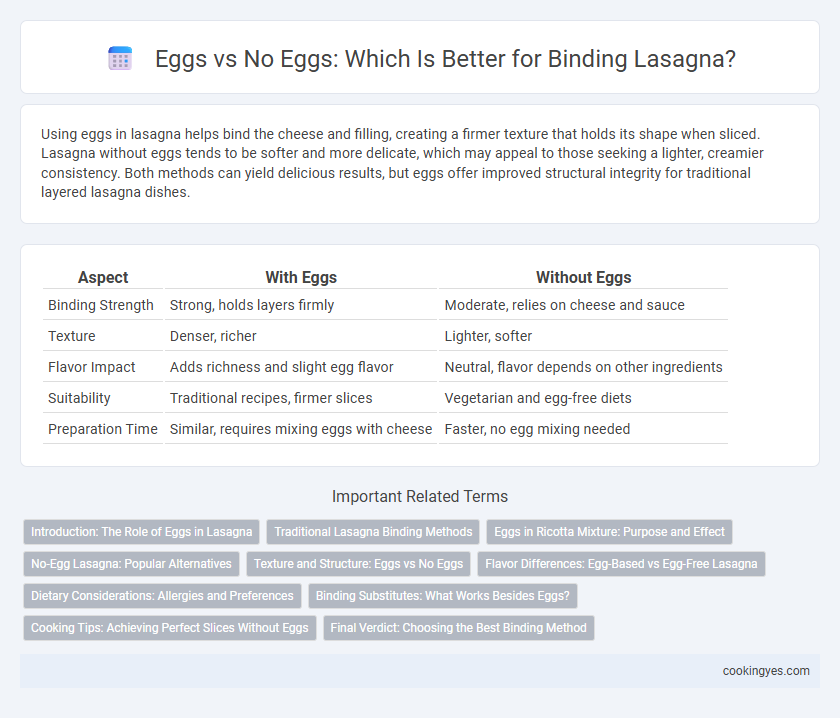Using eggs in lasagna helps bind the cheese and filling, creating a firmer texture that holds its shape when sliced. Lasagna without eggs tends to be softer and more delicate, which may appeal to those seeking a lighter, creamier consistency. Both methods can yield delicious results, but eggs offer improved structural integrity for traditional layered lasagna dishes.
Table of Comparison
| Aspect | With Eggs | Without Eggs |
|---|---|---|
| Binding Strength | Strong, holds layers firmly | Moderate, relies on cheese and sauce |
| Texture | Denser, richer | Lighter, softer |
| Flavor Impact | Adds richness and slight egg flavor | Neutral, flavor depends on other ingredients |
| Suitability | Traditional recipes, firmer slices | Vegetarian and egg-free diets |
| Preparation Time | Similar, requires mixing eggs with cheese | Faster, no egg mixing needed |
Introduction: The Role of Eggs in Lasagna
Eggs act as a natural binder in lasagna, enhancing the texture by providing structure and preventing the layers from separating during baking. Recipes with eggs typically yield a firmer, more cohesive dish, while egg-free alternatives rely on cheeses like ricotta or bechamel sauce for binding. Choosing between eggs or no eggs depends on dietary preferences and desired lasagna consistency.
Traditional Lasagna Binding Methods
Traditional lasagna binding methods often include eggs to help the cheese and pasta layers adhere, creating a firm and cohesive texture during baking. Recipes without eggs rely on the natural starches of pasta and moisture from ricotta or bechamel sauce to achieve a softer, creamier consistency. The choice between eggs and no eggs influences the structure and mouthfeel of lasagna, with eggs providing stability and no-egg versions offering a lighter, more delicate layering.
Eggs in Ricotta Mixture: Purpose and Effect
Eggs in the ricotta mixture act as a binding agent, enhancing the structure and firmness of lasagna layers, preventing them from becoming too watery or loose. The proteins in eggs coagulate during baking, which helps maintain the shape and provides a creamy, cohesive texture. Using eggs in ricotta contributes to a richer mouthfeel and ensures a stable, sliceable lasagna that holds together well when served.
No-Egg Lasagna: Popular Alternatives
No-egg lasagna recipes often rely on ricotta cheese or bechamel sauce to achieve a creamy, cohesive texture without eggs. Silken tofu or cashew-based cheese can serve as popular vegan alternatives that bind layers effectively while adding moisture. These ingredients maintain structural integrity and enhance flavor, making them ideal for egg-free lasagna variations.
Texture and Structure: Eggs vs No Eggs
Eggs in lasagna contribute to a firmer texture and improved structural integrity by binding the layers together, resulting in a cohesive slice that holds its shape well during serving. Without eggs, lasagna tends to have a softer, more delicate texture, with layers that may be looser or more prone to separating but offer a lighter mouthfeel. The choice between eggs and no eggs impacts the balance between firmness and tenderness, influencing the overall eating experience and presentation.
Flavor Differences: Egg-Based vs Egg-Free Lasagna
Egg-based lasagna typically offers a richer, creamier texture and a slightly custardy flavor due to the proteins and fats in the eggs enhancing the sauce's body. In contrast, egg-free lasagna has a lighter, fresher taste as the absence of eggs allows the tomato sauce, herbs, and cheese to shine without added richness. Flavor profiles of egg-free versions tend to highlight tanginess and herbaceous notes, creating a more vibrant and clean palate experience.
Dietary Considerations: Allergies and Preferences
Using eggs in lasagna provides a rich texture and helps bind the cheese and filling, but it may pose allergy risks for those sensitive to eggs. Egg-free lasagna options cater to vegan diets and individuals with egg allergies, often using alternatives like tofu, cashew cream, or flaxseed to maintain cohesion. Choosing between eggs or no eggs affects not only texture but also dietary suitability, making it essential to consider personal allergies and preferences.
Binding Substitutes: What Works Besides Eggs?
Eggs are commonly used in lasagna to provide binding and structure, but alternatives such as ricotta cheese, bechamel sauce, or mashed tofu offer effective binding without eggs. These substitutes enhance texture and moisture while accommodating dietary restrictions like vegan or egg-free diets. Incorporating cooked spinach or blended cashews can also improve cohesion and add flavor complexity in egg-free lasagna recipes.
Cooking Tips: Achieving Perfect Slices Without Eggs
Using eggs in lasagna helps bind the layers together, creating firmer slices, but omitting eggs can yield a lighter texture with proper technique. To achieve perfect slices without eggs, ensure the bechamel or cheese mixture is thickened adequately and allow the lasagna to cool and rest before cutting. Using a sharp, serrated knife and gently wiping the knife between cuts prevents sticking and maintains clean, defined layers.
Final Verdict: Choosing the Best Binding Method
Using eggs as a binder in lasagna enhances the texture by creating a firmer, creamier consistency that holds layers together well during baking. Egg-free alternatives rely on ricotta, bechamel sauce, or even mashed vegetables to achieve a lighter, more delicate structure without compromising moisture. The best binding method ultimately depends on dietary preferences and desired texture, with eggs offering sturdiness while no-egg options provide a softer, more traditional Italian experience.
Eggs vs No eggs for Lasagna binding Infographic

 cookingyes.com
cookingyes.com